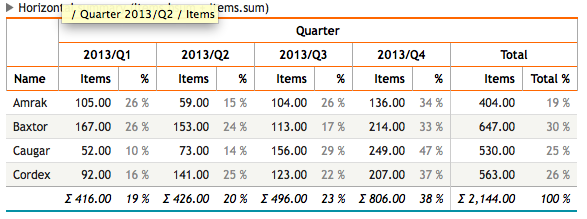Commands
dbr.sum - Calculates the sum of the selected columndbr.min - Calculates the minimum value of the selected columndbr.max - Calculates the maximum value of the selected columndbr.count - Calculates the number of non-null valuesdbr.countr - Calculates rowsdbr.countd - Calculates the distinct number of non-null valuesdbr.avg - Calculates the average of selected columndbr.sum.prefix - Set's the prefix to be used with dbr.sumdbr.min.prefix - Set's the prefix to be used with dbr.mindbr.max.prefix - Set's the prefix to be used with dbr.maxdbr.count.prefix - Set's the prefix to be used with dbr.countdbr.countd.prefix - Set's the prefix to be used with dbr.countddbr.avg.prefix - Set's the prefix to be used with dbr.avgdbr.summary.text - Adds text to summary rowdbr.calc - Allows you to create calculation formulas to populate cellsdbr.summary.calc - Same as dbr.calc. Kept for compatibility with older versionsdbr.summary.options - Change the default aggregate calculation
Syntax
select 'dbr.sum', ColumnReference [, ColumnReference ...]
select 'dbr.min', ColumnReference [, ColumnReference ...]
select 'dbr.max', ColumnReference [, ColumnReference ...]
select 'dbr.count', ColumnReference [, ColumnReference ...]
select 'dbr.countr', ColumnReference [, ColumnReference ...]
select 'dbr.count', ColumnReference [, ColumnReference ...]
select 'dbr.avg', ColumnReference [, ColumnReference ...]
select 'dbr.sum.prefix', ColumnReference, 'prefix'
select 'dbr.min.prefix', ColumnReference, 'prefix'
select 'dbr.max.prefix', ColumnReference, 'prefix'
select 'dbr.count.prefix', ColumnReference, 'prefix'
select 'dbr.countd.prefix', ColumnReference, 'prefix'
select 'dbr.avg.prefix', ColumnReference, 'prefix'
select 'dbr.summary.text', ColumnReference, TextOrColumnReference[, forsubrows ]
select 'dbr.calc', ColumnReference|ColumnReference.aggregate, Formula[, summary_format[, level, 'force' | 'force_summary']]
select 'dbr.summary.calc', ColumnReference, Formula
select 'dbr.summary.options', 'option' [, value]
Where:
- ColumnReference
- see Column reference for syntax.
- TextWithColumnReference
- Plain text or text with reference to column. Example: "Active users [active_summary_column]"
- Formula
- Any PHP compatible calculation that can include column references ([colref]). Example: "([col1]+[col1])/100"
- ColumnReference.aggregate
- An aggregate function applied to a column. Vertical aggregates are calculated over rows:
Horizontal aggregates are calculated over data columns in crosstable for each row:
- sum Calculates the sum of a column's values. Format: [colref.sum]
- min Calculates the minimum of a column's values. Usage: [colref.min]
- max Calculates the maximum of a column's values. Usage: [colref.max]
- avg Calculates the average of a column's values. Usage: [colref.avg]
- count Calculates a count of the rows. Usage: [colref.count]
- hsum Calculates sum crosstab column values. Usage: [colref.hsum]
- hmin Calculates the minimum of a column's values. Usage: [colref.hmin]
- hmax Calculates the maximum of a column's values. Usage: [colref.hmax]
- havg Calculates the average of a column's values. Usage: [colref.havg]
- hminus Calculates C1-C2-C3. Usage: [colref.hminus]
- hcount Calculates count crosstab data columns. Usage: [colref.hcount]
- summary_format
- A format string to format dbr.calc on summary rows (for example "%.0f cases")
- level
- Limitation into which summary levels / rows dbr.calc is calculated into: "0"=level 0 only, "1"=level 1 only, "<2"=rows, level 0 and 1
- force | force_summary
- By default, dbr.calc performs the calculation only on cells with no value. By using 'force' / 'force_summary' option the calculations are performed on all rows / sumnmary rows only
With aggregate functions, you can calculate the sum, minimum, maximum value, and count of individual rows for a column in the result set. If the result set includes header levels, the calculation is also performed for each break level.
dbr.summary.options include:
-
limit_summary_level, level- Calculate summaries only to a certain level (0=just total, 1=levels 0..1, 2=levels 0..2, or '=1' for only header level 1 skipping 0) -
skip_single_line_summary- Do not include summary lines if the summary level has only one row
We'll calculate a summary for Items and the Weight column and also the maximum for Weight
select 'dbr.sum', 'Items', 'Weight'; /* Calculate sum from Items and Weight column */ select 'dbr.max', 'Weight'; /* Calculate sum from Items and Weight column */ select 'dbr.count', 'Title'; select Title, sum(Items), sum(Weight) as 'Weight' from mydb.Exampledata group by Title;
This will produce the following result:
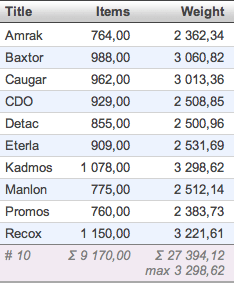
If an header level is included, the subtotals are also calculated:
select 'dbr.hdr', 'Year'; /* Sets the Year to be a header column */ select 'dbr.sum', 'Items', 'Weight'; /* Calculate sum from Items and Weight column */ select 'dbr.max', 'Weight'; /* Calculate sum from Items and Weight column */ select 'dbr.count', 'Title'; /* How many rows do we have? */ select 'dbr.summary.text', 'Year', 'Total'; select Year, Title, Items, Weight from mydb.Exampledata order by Year, Title;
Subtotals are calculated and the text appears in the summary row:
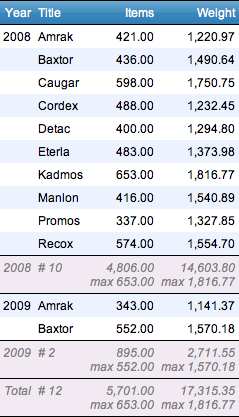
The dbr.calc command allows the insertion of formulas for a column.
References to other columns are made using the Column reference.
You can freely add any complex formula using PHP syntax.
In addition to column references, one can use references to aggregate values (horizontal and vertical) by using syntax [column.sum] for vertical aggregate values and [column.hsum] for horizontal aggregate values (crosstab values). This syntax can be used for all aggregates (sum, min, max, count, avg).
When performing calculations, the formula is applied to all columns that are not null.
In the example, if we want to calculate the percentage based on two columns, we reserve a place for the calculation by including a null value in the query and assigning it a column reference (e.g., "percent").
select 'dbr.sum', 'ok', 'all';
select 'dbr.calc', 'percent', '[ok]/[all]*100';
select Group,
OK[ok],
allresults as 'All[all]',
null as '%[percent]'
from group_sessions;
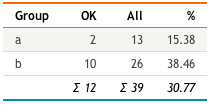
When a calculation formula is applied to the crosstable data value, it is performed for each dataset.
select 'dbr.sum', 'ok', 'all';
select 'dbr.hsum', 'ok', 'all';
select 'dbr.hdr', 'group';
select 'dbr.crosstab', 'session';
select 'dbr.colstyle', 'percent', '%.2f %';
select 'dbr.summary.text', 'group', 'Total';
select 'dbr.calc', 'percent', '[ok]/[all]*100';
select Group[group],
Session[session],
OK[ok],
allresults as 'All[all]',
null as '%[percent]'
from group_sessions;

An aggregate column reference can refer to the aggregate value for the column. A normal use case is where we need to calculate a percent share of each column of the total value.
The [Items.sum] reference in the formula refers to the total sum of the Items column.
select 'dbr.subtitle', 'Vertical summary'; select 'dbr.calc', 'percent', '[Items]/[Items.sum]*100'; select 'dbr.colstyle', 'percent', '%.0f %'; select 'dbr.sum', 'Items'; select Name, sum(Items) as 'Items', null as '%[percent]' from mydata group by Name;
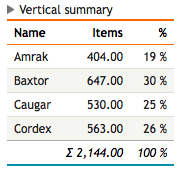
A horizontal aggregate column reference performs calculations over the data columns in a crosstable. In this example, we'll calculate the share for each quarter of the total year for each row.
The [Items] refers to each items column (each quarter). The [Items.hsum] refers to the total column and is independent of the actual Total column generated by the dbr.hsum command. The dbr.hnull command generates a placeholder (a null column) for the percent-column.
select 'dbr.subtitle', 'Horizontal summary (Items.hsum)'; select 'dbr.crosstab', 'quarter'; select 'dbr.calc', 'percent', '[Items]/[Items.hsum]*100'; select 'dbr.hnull', 'percent'; select 'dbr.colstyle', 'percent', '[color:#888]%.0f %'; select 'dbr.sum', 'Items'; select 'dbr.hsum', 'Items'; select Name, f_quarter(thedate) as 'Quarter[quarter]', sum(Items) as 'Items', null as '%[percent]' from mydata group by Name, 2;
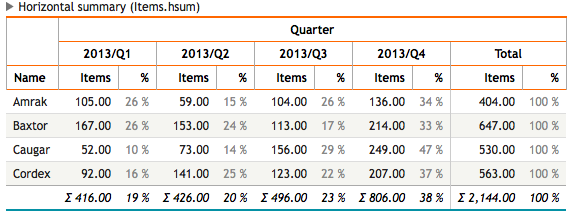
The following example combines both calculation methods. The result differs from the earlier example in that the total percent column will show the percentage of each row's total value from the grand total.
To achieve this, we'll use the dbr.hnull command to create a placeholder for the row total.
select 'dbr.subtitle', 'Horizontal summary (Items.hsum + Items.sum)'; select 'dbr.crosstab', 'quarter'; /* Calculate percent for data columns */ select 'dbr.calc', 'data_percent', '[Items]/[Items.hsum]*100'; /* Create a placeholder null-column for the total_percent */ select 'dbr.hnull', 'total_percent'; /* Calculate the total_percent */ select 'dbr.calc', 'total_percent', '[Items]/[Items.sum]*100'; /* We do not need to show the row percentage for each data column, only in total column */ select 'dbr.hidecolumn.data', 'total_percent'; /* Fade the percent columns a bit to make table more readable */ select 'dbr.colstyle', 'data_percent', '[color:#888]%.0f %'; select 'dbr.colstyle', 'total_percent', '[color:#888]%.0f %'; select 'dbr.sum', 'Items'; select 'dbr.hsum', 'Items'; select Name, f_quarter(thedate) as 'Quarter[quarter]', sum(Items) as 'Items', null as '%[data_percent]', null as 'Total %[total_percent]' from mydata group by Name, 2;
